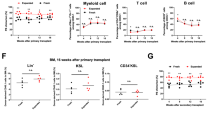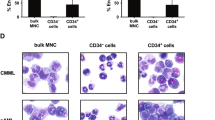Abstract
We hypothesized that human hematopoietic cells displaying a CD34+, kit+, rhodamine123low phenotype would be highly enriched for cells with stem-like properties. To test this hypothesis, we employed fluorescence activated cell sorting (FACS) to isolate cells with this phenotype from normal light density marrow mononuclear cells (MNC). CD34+, kit+, rhodamine123low cells comprised from 0.05–0.01% of the total MNC population. They were small, had scant cytoplasm, and contained nuclei with dense, hyperchromatic chromatin and inconspicuous nucleoli. Additional immunophenotyping revealed that these cells were CD33−, CD38−, CD20−, and glycophorin A−. When plated in semisolid cultures containing optimal concentrations of IL-3, GM-CSF, KL, EPO, IL-6, and IL-1 these cells did not form colonies. However, when cultured over irradiated stromal cells, cobblestone areas were observed to form after 3 weeks, and harvested cells were able to initiate long-term cultures. To further demonstrate that these cells were indeed stem like, we also tested their ability to engraft and mature in immunocompromised (SCID) mice. Irradiated (400 cGy) SCID mice were transplanted with 2 × 103 candidate stem cells which were then injected with recombinant human growth factors every other day. Two months post-transplant the animals were sacrificed. PCR and FACS analysis of marrow and spleen cell samples revealed the presence of cells expressing human CD45 consistent with engraftment of human stem cells and the establishment of murine–human chimerism. Moreover, MNC isolated from transplanted mice formed unambiguously human BFU-E, CFU-GM and B cell colonies when stimulated with the appropriate growth factors. Accordingly, we have identified a relatively rapid and simple mechanism for isolating primitive human hematopoietic cells with stem cell-like properties. We anticipate that this strategy will be useful for experimental and therapeutic applications that require human stem cells in quantity.
This is a preview of subscription content, access via your institution
Access options
Subscribe to this journal
Receive 12 print issues and online access
$259.00 per year
only $21.58 per issue
Buy this article
- Purchase on Springer Link
- Instant access to full article PDF
Prices may be subject to local taxes which are calculated during checkout
Similar content being viewed by others
Author information
Authors and Affiliations
Rights and permissions
About this article
Cite this article
Ratajczak, M., Pletcher, C., Marlicz, W. et al. CD34+, kit+, rhodamine123low phenotype identifies a marrow cell population highly enriched for human hematopoietic stem cells. Leukemia 12, 942–950 (1998). https://doi.org/10.1038/sj.leu.2401027
Received:
Accepted:
Published:
Issue Date:
DOI: https://doi.org/10.1038/sj.leu.2401027
Keywords
This article is cited by
-
Optimized Transduction of Canine Paediatric CD34+ Cells Using an MSCV-based Bicistronic Vector
Veterinary Research Communications (2006)
-
Transplantation studies in C3-deficient animals reveal a novel role of the third complement component (C3) in engraftment of bone marrow cells
Leukemia (2004)
-
Characterization of CD34+ subsets derived from bone marrow, umbilical cord blood and mobilized peripheral blood after stem cell factor and interleukin 3 stimulation
Bone Marrow Transplantation (2000)



